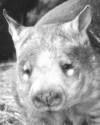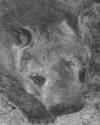|
(Lasiorhinus krefftii) The following article is printed with special thanks and appreciation to the Environmental Protection Agency of the Queensland Parks and Wildlife Service. General
The Northern Hairy-nosed Wombat was known from only three localities: Deniliquin, NSW; St. George, Southern Queensland; and Epping Forest, Central Queensland. At the time of European settlement, the species may already have been uncommon. It is assumed that drought and grazing pressure from cattle and sheep accelerated the species decline and that it was extinct in the Deniliquin and St. George areas by 1908. The Northern Hairy-nosed Wombat is now restricted to a single population in Epping Forest National Park near Claremont in Central Queensland. At last count the population contained 110 individuals.
Queensland Parks and Wildlife Service has produced a recovery plan for the Northern hairy-nosed Wombat, which outlines the actions needed to halt its decline and enhance the chances for long term survival in the wild. These actions are being implemented by QPWS as part of a major recovery program to save the Northern hairy-nosed Wombat.
The following provides information on the Wombat, the threat to its survival and what is being done to conserve the species.
Description
Australia has three species of Wombat, the Northern Hairy-nosed Wombat, Lasiorhinus krefftii the Southern Hairy-nosed Wombat, Lasiorhinus latifrons, and the Common Wombat Vombatus ursinus. The Northern Hairy-nosed Wombat is the largest of the Wombats and the biggest burrowing mammal in the world. This nocturnal marsupial, with its silky grey fur and broad hairy nose, can weigh up to 40kgs. Females are slightly heavier than males. The two species of hairy-nosed wombats are similar in appearance but differ from the Common wombats by having broader, hairy noses, silkier fur and longer ears.* The Southern Hairy-nosed Wombat and the Common Wombat are not found in the same location as the Northern Hairy-nosed Wombat.
Habitat
Epping Forest national Park is semi-arid and dominated by Brigalow, Acacia harpophylla and Gidgee, Acacia cambagei on heavy grey non-cracking soils. Deep alluvial sand deposits are present along an ancient watercourse, on the banks of which Wombats dig burrows. Wombat habitat is dominated by Long-fruited Bloodwood, Corymbia clarksonia, Moreton Bay Ash, C. tessellaris and Bauhinia, Lysiphyllum hookeri, with a grassy ground cover.
Behaviour
In Summer months, Northern Hairy-nosed Wombats will only leave their burrows in the hours of darkness when the air temperature is cooler. On Winter days they may be seen sunning themselves above ground During the dry season (May to October), the Wombats are active for about six hours per night. In the wet season (November to April), when more food is available, activity at night decreases to about two hours.
Breeding
Breeding is related to Summer rainfall, occurring less frequently during times of drought. Young are born mostly in the wet season. The young remain in the pouch for 6 to 9 months and then stay in the burrow for an unknown period of time, while their mother goes out to feed. Weaning occurs at about twelve months of age.
Threatening Processes
Overgrazing by cattle and drought appear to be the main factors contributing to the species’ decline. Cattle have been removed from Epping Forest National Park, so grazing pressure from livestock is no longer considered a threat. Current threatening processes are: loss of genetic diversity, small population size, predation by dingoes, being restricted to one location, disease and parasites affecting the health of the animals, wildlife and drought destroying food sources, and competition for food from Eastern Grey Kangaroos Macropus giganteus, especially during droughts.
What’s being Done
The breeding status, health and population structure of the wombats is being monitored. The habitat is being managed through pasture manipulation, and by the provision of supplementary feed and water. In addition, fire breaks around the Park are being maintained, dingoes are baited regularly and the population density of kangaroos is monitored at least twice a year.
A captive colony of Southern Hairy-nosed Wombats is being established in Rockhampton to develop assisted breeding and husbandry techniques that can be applied to the Northern Hairy-nosed Wombat. Pouch young cross fostering (removing a pouch young from a Northern Hairy-nosed wombat and allowing it to be raised by a female Southern Hairy-nosed Wombat) is being investigated to increase reproductive output. Trials are underway with Southern Hairy-nosed Wombats to refine the procedures. Northern hairy-nosed Wombat semen has been collected and cryopreserved to ensure against any further population declines. When the population of Northern Hairy-nosed Wombats increases a second wild population will be established.
Where can I see them?
Sorry, access to Epping Forest National Park is restricted to the wombat managers and researchers to minimise disturbance to the wombats. In September 2001, the Wombat Research Centre will open in Rockhampton. You will be able to view Common and Southern Hairy-nosed Wombats and visit the Northern Hairy-nosed Wombat display.
Further information
On Threatened
Species Management:-
The
Coordinator
On the
Northern
Hairy-nosed Wombat
Dr.
Alan Horsup
The recovery plan is available from the website at
*Additional
note
by Bob Cleaver:
|
||||
|
Back to top Back to Home page This site hosted by
|

